Microsoft DP-100 Exam Practice Questions (P. 3)
- Full Access (528 questions)
- Six months of Premium Access
- Access to one million comments
- Seamless ChatGPT Integration
- Ability to download PDF files
- Anki Flashcard files for revision
- No Captcha & No AdSense
- Advanced Exam Configuration
Question #21
HOTSPOT -
Complete the sentence by selecting the correct option in the answer area.
Hot Area:
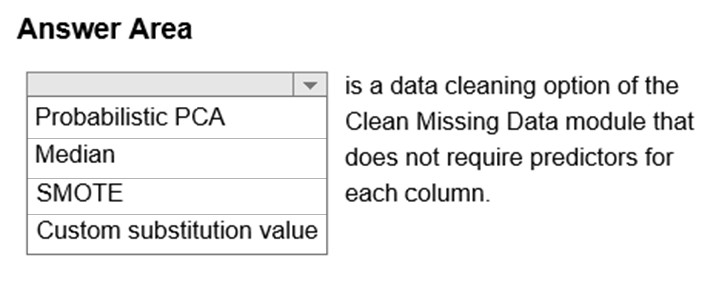
Complete the sentence by selecting the correct option in the answer area.
Hot Area:

Correct Answer:
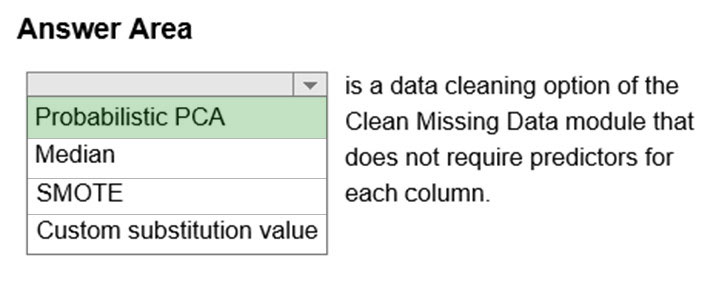
Replace using Probabilistic PCA: Compared to other options, such as Multiple Imputation using Chained Equations (MICE), this option has the advantage of not requiring the application of predictors for each column. Instead, it approximates the covariance for the full dataset. Therefore, it might offer better performance for datasets that have missing values in many columns.
Reference:
https://docs.microsoft.com/en-us/azure/machine-learning/studio-module-reference/clean-missing-data

Replace using Probabilistic PCA: Compared to other options, such as Multiple Imputation using Chained Equations (MICE), this option has the advantage of not requiring the application of predictors for each column. Instead, it approximates the covariance for the full dataset. Therefore, it might offer better performance for datasets that have missing values in many columns.
Reference:
https://docs.microsoft.com/en-us/azure/machine-learning/studio-module-reference/clean-missing-data
send
light_mode
delete
Question #22
You have recently concluded the construction of a binary classification machine learning model.
You are currently assessing the model. You want to make use of a visualization that allows for precision to be used as the measurement for the assessment.
Which of the following actions should you take?
You are currently assessing the model. You want to make use of a visualization that allows for precision to be used as the measurement for the assessment.
Which of the following actions should you take?
- AYou should consider using Venn diagram visualization.
- BYou should consider using Receiver Operating Characteristic (ROC) curve visualization.
- CYou should consider using Box plot visualization.
- DYou should consider using the Binary classification confusion matrix visualization.Most Voted
Correct Answer:
D
Reference:
https://docs.microsoft.com/en-us/azure/machine-learning/how-to-understand-automated-ml#confusion-matrix
D
Reference:
https://docs.microsoft.com/en-us/azure/machine-learning/how-to-understand-automated-ml#confusion-matrix
send
light_mode
delete
Question #23
This question is included in a number of questions that depicts the identical set-up. However, every question has a distinctive result. Establish if the recommendation satisfies the requirements.
You have been tasked with evaluating your model on a partial data sample via k-fold cross-validation.
You have already configured a k parameter as the number of splits. You now have to configure the k parameter for the cross-validation with the usual value choice.
Recommendation: You configure the use of the value k=1.
Will the requirements be satisfied?
You have been tasked with evaluating your model on a partial data sample via k-fold cross-validation.
You have already configured a k parameter as the number of splits. You now have to configure the k parameter for the cross-validation with the usual value choice.
Recommendation: You configure the use of the value k=1.
Will the requirements be satisfied?
- AYes
- BNoMost Voted
Correct Answer:
B
B
 GPT-4o - Answer
GPT-4o - Answer
The suggestion to use k=1 for k-fold cross-validation won't meet our criteria here. Typically, using a k-value of between 5 to 10 is standard since it strikes the right balance—enough data per fold for training and plenty of splits to accurately gauge model reliability and performance. Rolling with just k=1 would essentially mean no cross-validation, as it divides the data into one single train and test set—definitely not what we're after for thorough validation.
send
light_mode
delete
Question #24
DRAG DROP -
You are in the process of constructing a regression model.
You would like to make it a Poisson regression model. To achieve your goal, the feature values need to meet certain conditions.
Which of the following are relevant conditions with regards to the label data? Answer by dragging the correct options from the list to the answer area.
Select and Place:
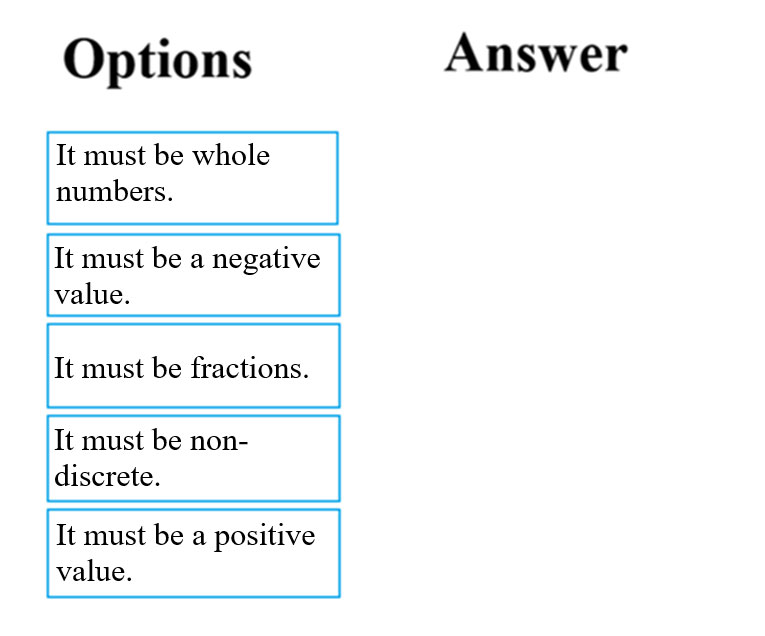
You are in the process of constructing a regression model.
You would like to make it a Poisson regression model. To achieve your goal, the feature values need to meet certain conditions.
Which of the following are relevant conditions with regards to the label data? Answer by dragging the correct options from the list to the answer area.
Select and Place:

Correct Answer:
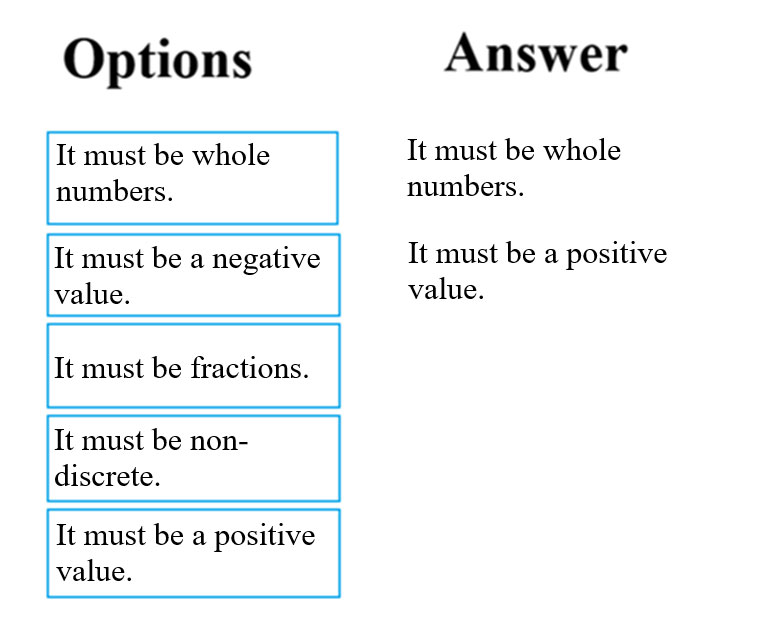
Poisson regression is intended for use in regression models that are used to predict numeric values, typically counts. Therefore, you should use this module to create your regression model only if the values you are trying to predict fit the following conditions:
✑ The response variable has a Poisson distribution.
✑ Counts cannot be negative. The method will fail outright if you attempt to use it with negative labels.
✑ A Poisson distribution is a discrete distribution; therefore, it is not meaningful to use this method with non-whole numbers.
Reference:
https://docs.microsoft.com/en-us/azure/machine-learning/studio-module-reference/poisson-regression

Poisson regression is intended for use in regression models that are used to predict numeric values, typically counts. Therefore, you should use this module to create your regression model only if the values you are trying to predict fit the following conditions:
✑ The response variable has a Poisson distribution.
✑ Counts cannot be negative. The method will fail outright if you attempt to use it with negative labels.
✑ A Poisson distribution is a discrete distribution; therefore, it is not meaningful to use this method with non-whole numbers.
Reference:
https://docs.microsoft.com/en-us/azure/machine-learning/studio-module-reference/poisson-regression
send
light_mode
delete
Question #25
This question is included in a number of questions that depicts the identical set-up. However, every question has a distinctive result. Establish if the recommendation satisfies the requirements.
You are in the process of carrying out feature engineering on a dataset.
You want to add a feature to the dataset and fill the column value.
Recommendation: You must make use of the Group Categorical Values Azure Machine Learning Studio module.
Will the requirements be satisfied?
You are in the process of carrying out feature engineering on a dataset.
You want to add a feature to the dataset and fill the column value.
Recommendation: You must make use of the Group Categorical Values Azure Machine Learning Studio module.
Will the requirements be satisfied?
- AYes
- BNoMost Voted
Correct Answer:
B
B
 GPT-4o - Answer
GPT-4o - Answer
The recommendation to use the "Group Categorical Values" module in Azure Machine Learning Studio does not meet the stated requirement of adding a new feature and filling the column value. This module is specifically tailored for managing the complexity of categorical data by grouping values, reducing the number of unique categories. It essentially helps to simplify the data which is useful in certain scenarios but will not assist in creating new features or specifically in initializing them with values. Therefore, the correct answer is indeed "No".
send
light_mode
delete
Question #26
This question is included in a number of questions that depicts the identical set-up. However, every question has a distinctive result. Establish if the recommendation satisfies the requirements.
You are in the process of carrying out feature engineering on a dataset.
You want to add a feature to the dataset and fill the column value.
Recommendation: You must make use of the Join Data Azure Machine Learning Studio module.
Will the requirements be satisfied?
You are in the process of carrying out feature engineering on a dataset.
You want to add a feature to the dataset and fill the column value.
Recommendation: You must make use of the Join Data Azure Machine Learning Studio module.
Will the requirements be satisfied?
- AYes
- BNoMost Voted
Correct Answer:
B
B
 GPT-4o - Answer
GPT-4o - Answer
Absolutely, the correct choice here is "No". If you simply want to add a new feature to your existing dataset, there's really no need to perform a join. Joins are typically used to combine rows from two or more tables based on a related column between them. However, for adding a new feature or column, you should utilize the "Add Columns" module in Azure Machine Learning Studio. This tool is specifically designed for such tasks and aligns perfectly with the requirements outlined in the scenario. Keep it straightforward and stick to the right tools for specific tasks!
send
light_mode
delete
Question #27
This question is included in a number of questions that depicts the identical set-up. However, every question has a distinctive result. Establish if the recommendation satisfies the requirements.
You are in the process of carrying out feature engineering on a dataset.
You want to add a feature to the dataset and fill the column value.
Recommendation: You must make use of the Edit Metadata Azure Machine Learning Studio module.
Will the requirements be satisfied?
You are in the process of carrying out feature engineering on a dataset.
You want to add a feature to the dataset and fill the column value.
Recommendation: You must make use of the Edit Metadata Azure Machine Learning Studio module.
Will the requirements be satisfied?
- AYes
- BNoMost Voted
Correct Answer:
A
Typical metadata changes might include marking columns as features.
Reference:
https://docs.microsoft.com/en-us/azure/machine-learning/studio-module-reference/edit-metadata https://docs.microsoft.com/en-us/azure/machine-learning/studio-module-reference/join-data https://docs.microsoft.com/en-us/azure/machine-learning/studio-module-reference/group-categorical-values
A
Typical metadata changes might include marking columns as features.
Reference:
https://docs.microsoft.com/en-us/azure/machine-learning/studio-module-reference/edit-metadata https://docs.microsoft.com/en-us/azure/machine-learning/studio-module-reference/join-data https://docs.microsoft.com/en-us/azure/machine-learning/studio-module-reference/group-categorical-values
send
light_mode
delete
Question #28
You have been tasked with ascertaining if two sets of data differ considerably. You will make use of Azure Machine Learning Studio to complete your task.
You plan to perform a paired t-test.
Which of the following are conditions that must apply to use a paired t-test? (Choose all that apply.)
You plan to perform a paired t-test.
Which of the following are conditions that must apply to use a paired t-test? (Choose all that apply.)
- AAll scores are independent from each other.
- BYou have a matched pairs of scores.Most Voted
- CThe sampling distribution of d is normal.Most Voted
- DThe sampling distribution of x1- x2 is normal.
Correct Answer:
BC
Reference:
https://docs.microsoft.com/en-us/azure/machine-learning/studio-module-reference/test-hypothesis-using-t-test
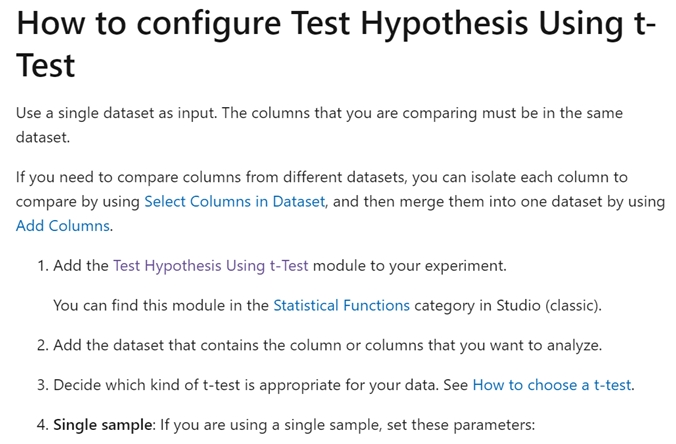
BC
Reference:
https://docs.microsoft.com/en-us/azure/machine-learning/studio-module-reference/test-hypothesis-using-t-test

send
light_mode
delete
Question #29
You want to train a classification model using data located in a comma-separated values (CSV) file.
The classification model will be trained via the Automated Machine Learning interface using the Classification task type.
You have been informed that only linear models need to be assessed by the Automated Machine Learning.
Which of the following actions should you take?
The classification model will be trained via the Automated Machine Learning interface using the Classification task type.
You have been informed that only linear models need to be assessed by the Automated Machine Learning.
Which of the following actions should you take?
- AYou should disable deep learning.Most Voted
- BYou should enable automatic featurization.
- CYou should disable automatic featurization.
- DYou should set the task type to Forecasting.
Correct Answer:
C
Reference:
https://econml.azurewebsites.net/spec/estimation/dml.html
https://docs.microsoft.com/en-us/azure/machine-learning/how-to-use-automated-ml-for-ml-models
C
Reference:
https://econml.azurewebsites.net/spec/estimation/dml.html
https://docs.microsoft.com/en-us/azure/machine-learning/how-to-use-automated-ml-for-ml-models
send
light_mode
delete
Question #30
You are preparing to train a regression model via automated machine learning. The data available to you has features with missing values, as well as categorical features with little discrete values.
You want to make sure that automated machine learning is configured as follows:
✑ missing values must be automatically imputed.
✑ categorical features must be encoded as part of the training task.
Which of the following actions should you take?
You want to make sure that automated machine learning is configured as follows:
✑ missing values must be automatically imputed.
✑ categorical features must be encoded as part of the training task.
Which of the following actions should you take?
- AYou should make use of the featurization parameter with the 'auto' value pair.Most Voted
- BYou should make use of the featurization parameter with the 'off' value pair.
- CYou should make use of the featurization parameter with the 'on' value pair.
- DYou should make use of the featurization parameter with the 'FeaturizationConfig' value pair.
Correct Answer:
A
Featurization str or FeaturizationConfig
Values: 'auto' / 'off' / FeaturizationConfig
Indicator for whether featurization step should be done automatically or not, or whether customized featurization should be used.
Column type is automatically detected. Based on the detected column type preprocessing/featurization is done as follows:
Categorical: Target encoding, one hot encoding, drop high cardinality categories, impute missing values.
Numeric: Impute missing values, cluster distance, weight of evidence.
DateTime: Several features such as day, seconds, minutes, hours etc.
Text: Bag of words, pre-trained Word embedding, text target encoding.
Reference:
https://docs.microsoft.com/en-us/python/api/azureml-train-automl-client/azureml.train.automl.automlconfig.automlconfig
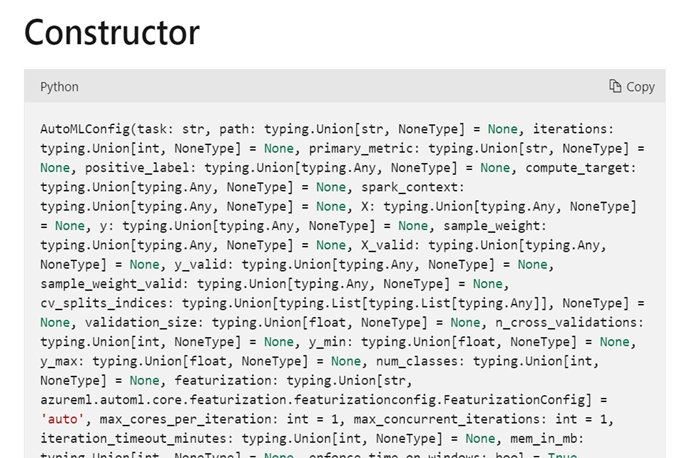
A
Featurization str or FeaturizationConfig
Values: 'auto' / 'off' / FeaturizationConfig
Indicator for whether featurization step should be done automatically or not, or whether customized featurization should be used.
Column type is automatically detected. Based on the detected column type preprocessing/featurization is done as follows:
Categorical: Target encoding, one hot encoding, drop high cardinality categories, impute missing values.
Numeric: Impute missing values, cluster distance, weight of evidence.
DateTime: Several features such as day, seconds, minutes, hours etc.
Text: Bag of words, pre-trained Word embedding, text target encoding.
Reference:
https://docs.microsoft.com/en-us/python/api/azureml-train-automl-client/azureml.train.automl.automlconfig.automlconfig

send
light_mode
delete
All Pages
